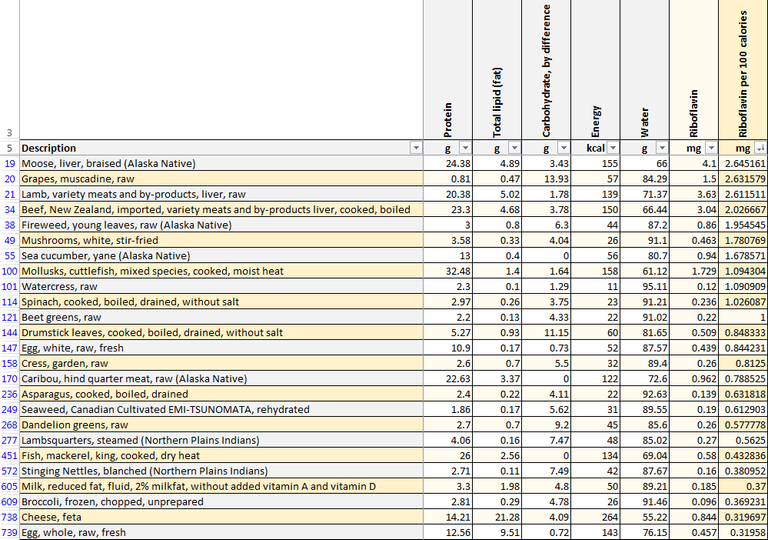Read the full Article on FooDosage.com
Riboflavin (also known as Vitamin B2) is a water-soluble vitamin in the B series, helps maintain normal levels of the amino acid homocysteine in the blood, and is an essential component of two major coenzymes responsible for cellular function, -growth, and -development, energy production, and metabolism of fats, drugs, and steroids: FMN and FAD.
- FMN (Flavin MonoNucleotide), also known as Riboflavin-5’-phosphate, is needed for the conversion of vitamin B6 to the coenzyme pyridoxal 5’-phosphate.
- FAD (Flavin Adenine Dinucleotide) is required for the conversion of the amino acid tryptophan to niacin (Vitamin B3).
Being water-soluble, it is stored in the liver, heart and kidneys in small amounts, but excess amounts will be expelled quickly. This means we need an adequate, ongoing (daily) supply to keep Riboflavin levels in the optimal range.
This article will cover the recommended intake levels, why we want to reach those levels, the dangers of overconsumption, and which foods are richest in Vitamin B2. As a twist, and starting with this article, we sort foods by their nutrient to calorie ratios, as opposed to the more common per 100 gram values. But more on the reasoning behind that decision later, in the Top Foods section.
Note that all recommended intake figures below are based on the needs of a 31 year old non-pregnant, non-lactating woman on a 2000 kilocalorie diet. Your personal requirements may differ (wildly). One way to figure out your individual needs, including calories per day, is the FooDosage Nutrition Calculator. It's free, by the way.
Recommended Riboflavin (Vitamin B2) Intake
The recommended intake range for Riboflavin, as set by the National Academy of Sciences:
Recommended minimum intake (RDA): 1.1 mg per day
Upper limit: -
Note that your personal requirements may differ depending on your age, sex, pregnancy-, and lactation status.
Importance of an Adequate Riboflavin Intake (Dangers of a Deficiency)
Riboflavin deficiencies are extremely rare in developed countries, but can occur if the corresponding foods are avoided, without supplemental compensation. Vegans and people who do not consume dairy products are especially at risk of this.
Light or early stage deficiencies can cause skin disorders, hyperemia (excess blood) and edema of the mouth and throat, angular stomatitis (lesions at the corners of the mouth), cheilosis (swollen, cracked lips), hair loss, reproductive problems, sore throat, itchy and red eyes, and degeneration of the liver and nervous system.
Severe and/or prolonged deficiencies can lead to Anemia and cataracts.
While early symptoms can commonly be cured by treating the deficiency with supplements, later stage physiological changes are not so easily reversed.
Risks of an Excessive Vitamin B2 Consumption (Side Effects)
As a water-soluble vitamin, excess Riboflavin is usually expelled via urine without complication. As opposed to fat soluble vitamins, liver toxicity is not a danger. Our bodies do store small amounts in the heart, liver and kidneys, but absorb no more than 27 mg from single doses.
Beyond that, no adverse effects associated with Vitamin B2 from food or supplements have been reported. This does not mean that there is no potential for adverse effects resulting from high intakes. Because data on the adverse effects of thiamine is limited, caution may be warranted.
In other terms, any amount of Riboflavin you can consume from food sources is most likely fine, but don't overdo it with supplements.
Top 12 Riboflavin (Vitamin B2) Food Sources
The highest concentrations of Riboflavin are generally found in organ meats, fish, leafy greens, some vegetables, and milk products.
Some choice examples of Vitamin B2 rich foods:
 Riboflavin Leaderboard - FooDosage Nutrition Calculator
Riboflavin Leaderboard - FooDosage Nutrition Calculator
Note that for this ranking, the foods were sorted by their nutrient/calorie contents, as opposed to the more common nutrient/gram sorting method. This is because per calorie values correct for water content, and satiation. Example: Butter may contain more Vitamin A than Spinach per 100 grams, but eating the 120 grams of spinach necessary to reach the minimum recommended amount of Vitamin A is by far more feasible (and recommendable) than to eat the 100 grams of butter required for the same amount of Vitamin A..
.
.
Read the full Article on FooDosage.com
.
.
.
Bon Appetit :-)
Sources:
http://www.nationalacademies.org/hmd/Activities/Nutrition/SummaryDRIs/DRI-Tables.aspx